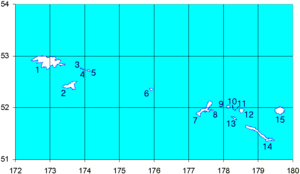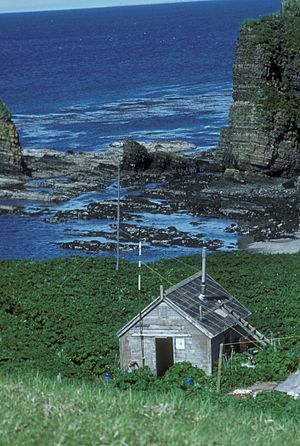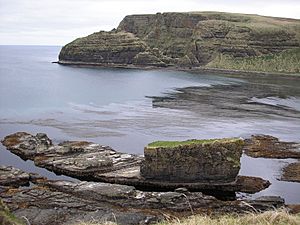Agattu facts for kids


Agattu (Aleut: Angatux̂; Russian: Агатту) is an island located in Alaska. It is part of the Near Islands, which are at the western end of the Aleutian Islands. Agattu is a large island, covering about 85.558 square miles (221.59 square kilometers). It is one of the biggest islands in the Aleutians where no one lives.
Agattu is the second largest of the Near Islands, right after Attu Island. The island was formed by volcanoes and has many mountains. It has no trees, and its land looks like a tundra, which is a cold, treeless plain. The highest point on Agattu is about 2,073 feet (632 meters) above sea level. The island is about 12.2 miles (19.7 kilometers) long and 18.6 miles (30 kilometers) wide.
Why Agattu is Special
Agattu is known for its unique environment and history.
A Home for Birds
Agattu has been named an Important Bird Area (IBA) by BirdLife International. This means it is a very important place for many different kinds of birds. It helps protect them and their habitats.
How the Island Formed
Agattu is different from other volcanic islands in the Aleutians. Most of its rocks are sedimentary, meaning they formed from layers of material deposited in water. These rocks mainly came from volcanic areas. The island also has some igneous rocks, which are formed from cooled lava. Long ago, glaciers covered the entire island, shaping its landscape.
People of Agattu
Scientists have found signs that people lived on Agattu Island a very long time ago. These people were Aleuts, and they were there as early as 760 BCE. Experts believe that before Europeans arrived, between 500 and 1,000 people might have lived on the island at the same time.
When Russian traders first came to the Aleutian Islands in 1751, the number of people on Agattu started to drop quickly. Russian traders often stayed for years to hunt sea otters. Sometimes, their meetings with the Aleuts were not peaceful. For example, a Russian sailor was killed by local people on Agattu in 1761.
By the 1760s, all the people from the Near Islands had moved to a single village on Attu Island. Later, during World War II, the villagers from Attu were sent to Japan. After the war, the people who survived were moved to Atka Island.
See also
 In Spanish: Isla Agattu para niños
In Spanish: Isla Agattu para niños



